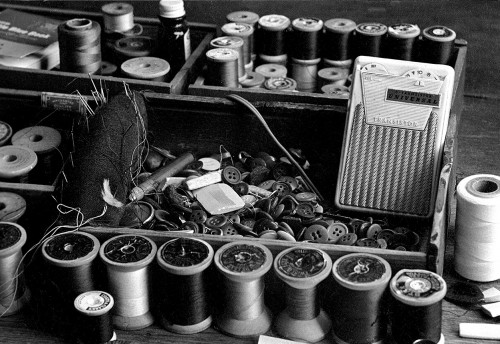 F.R. Richey was a tailor I photographed in 1968 in Athens, Ohio. He was in his 80s when I met him. He died at 96, after spending 70 years patching and sewing. This detail shot of his spools and a transistor radio got me to thinking about early radios I remember. If you sew or are interested in radios, click on the photo to make it larger.
F.R. Richey was a tailor I photographed in 1968 in Athens, Ohio. He was in his 80s when I met him. He died at 96, after spending 70 years patching and sewing. This detail shot of his spools and a transistor radio got me to thinking about early radios I remember. If you sew or are interested in radios, click on the photo to make it larger.
I wrote earlier about having a transistor radio that looked a lot like this one when I was delivering newspapers. Looks like Mr. Richey’s radio was a later model that actually had a speaker instead of making you listen through an earphone.
Cub Scout Crystal Radio
My first electronic project was to build a crystal radio set from a Cub Scout kit bought at Buckner-Ragsdale.
A crystal set consisted of an antenna to pick up the radio signal and convert it to electric currents; a tuning coil; a galena crystal that you touched with a fine piece of copper wire (the cat whisker); a ground and a pair of earphones. I used a gutter for the antenna. After getting everything hooked up, I would sit around carefully poking the pebble-sized crystal with the cat whisker until KFVS or KGMO would come flowing in. I don’t remember if I was ever able to pull in the St. Louis stations.
They could be made even simpler. During World War II, soldiers would make “foxhole radios” from a coil of wire, a rusty razor blade, a pencil lead and a pair of headphones. Because they were “passive” receivers, they couldn’t be discovered by German radio detection equipment.
Dad had a suitcase-sized “portable” radio that would shock the bejeebers out of you if you touched any of its metal parts when it was plugged into the wall.
